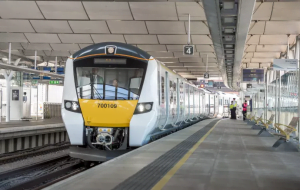Govia Thameslink Railway, who are working with Network Rail and Siemens, have scored a world first by running ATO (Automatic Train Operation) over ETCS (European Train Control System) on the mainline railway in passenger service.
On Saturday, 17th March 2018, a southbound 8-car Thameslink train, No. 700019, with a destination of Three Bridges, brought itself to a halt automatically at London St Pancras International at 13:53.
This was after it had transitioned into ETCS Level 2 Full Supervision, and then into ATO on its approach from the previous station, Kentish Town.
The driver was checking the platforms, closing the doors, and then selecting ATO again, the train with its in-cab signalling then continued under automatic control through Farringdon, City Thameslink, and London Blackfriars.
It finally transitioned out of ATO on its exit from London Blackfriars as it headed for Elephant & Castle.

This success is a milestone for the industry on its digital railway journey. Network Rail has completely replaced the signalling in central London. This allows trains to travel safely together. Siemens has provided the ETCS and ATO-enabled train, the Class 700 Desiro City.
What did the officials say?
GTR’s Systems Integration Manager Jim Doughty, said: “This is a real world-first and I’m delighted. It is the culmination of a programme of work that we have been involved in since the start of our franchise three years ago and which has been running continuously since the start of the £7bn Government-sponsored Thameslink Programme. It is critical to our RailPlan20/20 modernisation programme to modernise the busiest part of the UK rail network.
“Saturday’s run followed nearly two years of on-track testing and, working flawlessly, it has pathed the way for further runs. These runs will not only help build industry confidence in the system but also facilitate the commencement of the delivery of a world-class training package to our drivers in readiness for the increase in services.
“This cutting-edge system will allow us to run our final high-intensity Thameslink service of up to 24 trains per hour each way with 70% more seats through the centre of London, linking new communities and cutting journey times for thousands of passengers.”
Working with Network Rail and Siemens, GTR has run nearly 200 night and day shifts of testing since April 2016 when it began proving ETCS dynamically at Network Rail’s ETCS National Integration Facility at Hertford North in April 2016 and has had to demonstrate to the ORR that it has made the necessary amendments to its Health & Safety Management System to allow for the trains to operate in both ETCS & ATO in passenger service.
Martin Chatfield, Network Rail Project Director for High Capacity Infrastructure, said: “Seeing the first UK mainline train running in ATO for passenger services is a truly momentous day for the Thameslink Programme High Capacity Infrastructure Team and the wider industry teams that have been involved. This underlines the combined efforts of Network Rail, the supply chain, and the train operators over the past five years to reach this point. It not only proves the digital railway technology within the heavy rail environment, but it also demonstrates that an industry approach is a way to solving railway capacity issues in the future.”
Mark Ferrer, Operations Director Digital Rail, Siemens said: “This brings to life the hard work and commitment from the entire team, including Siemens, Network Rail, and GTR, proving the operation of digital signalling on a critical part of the railway infrastructure and realising the future of train control. The introduction of this technology, which was developed and delivered in the UK, maintains the UK’s position as a world leader in the application of technological solutions to the train control infrastructure, something that as an industry we aim to build on and further deploy.”
- Visit the Govia Thameslink Railway website
For more information - Visit the RailAdvent news homepage
For the latest railway news






Responses